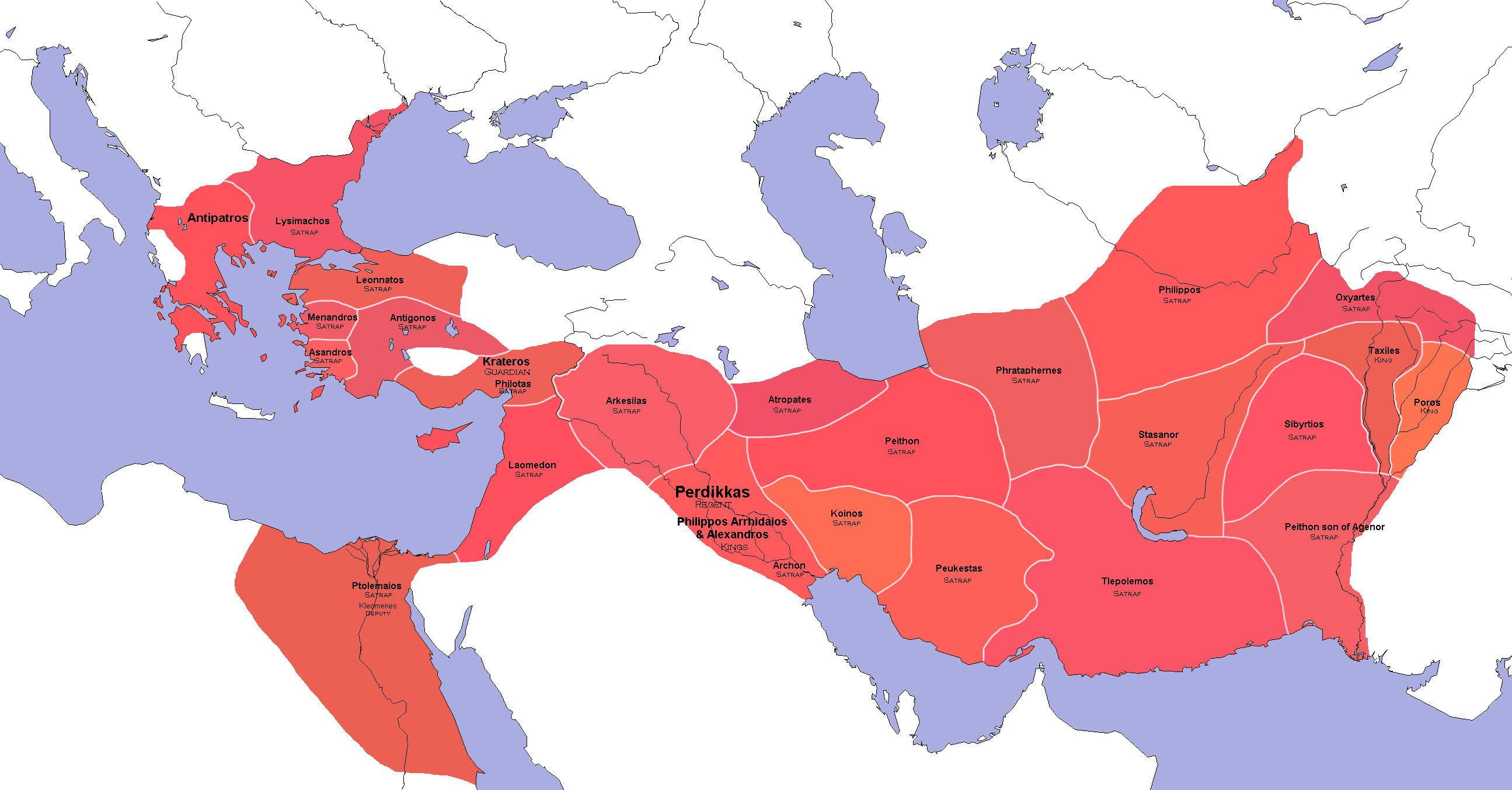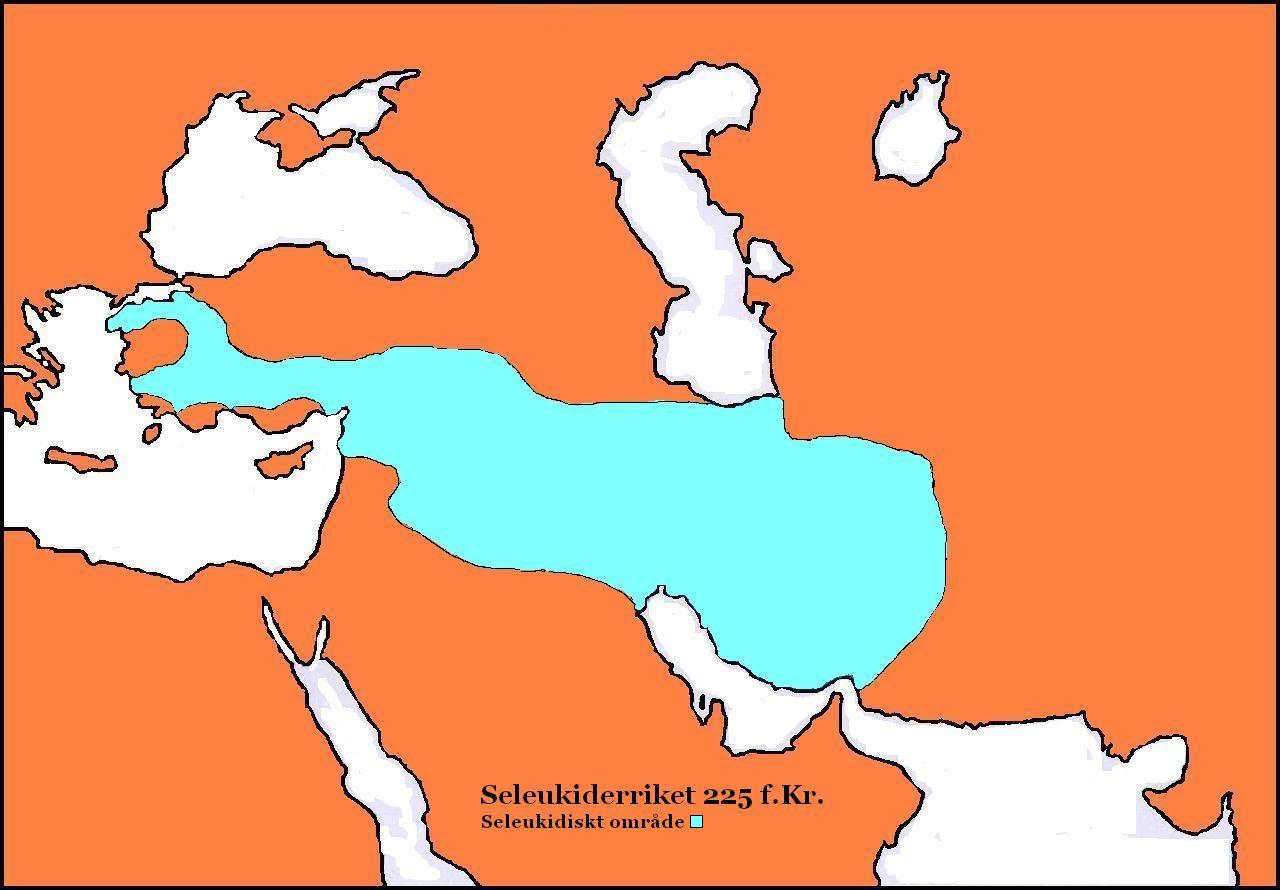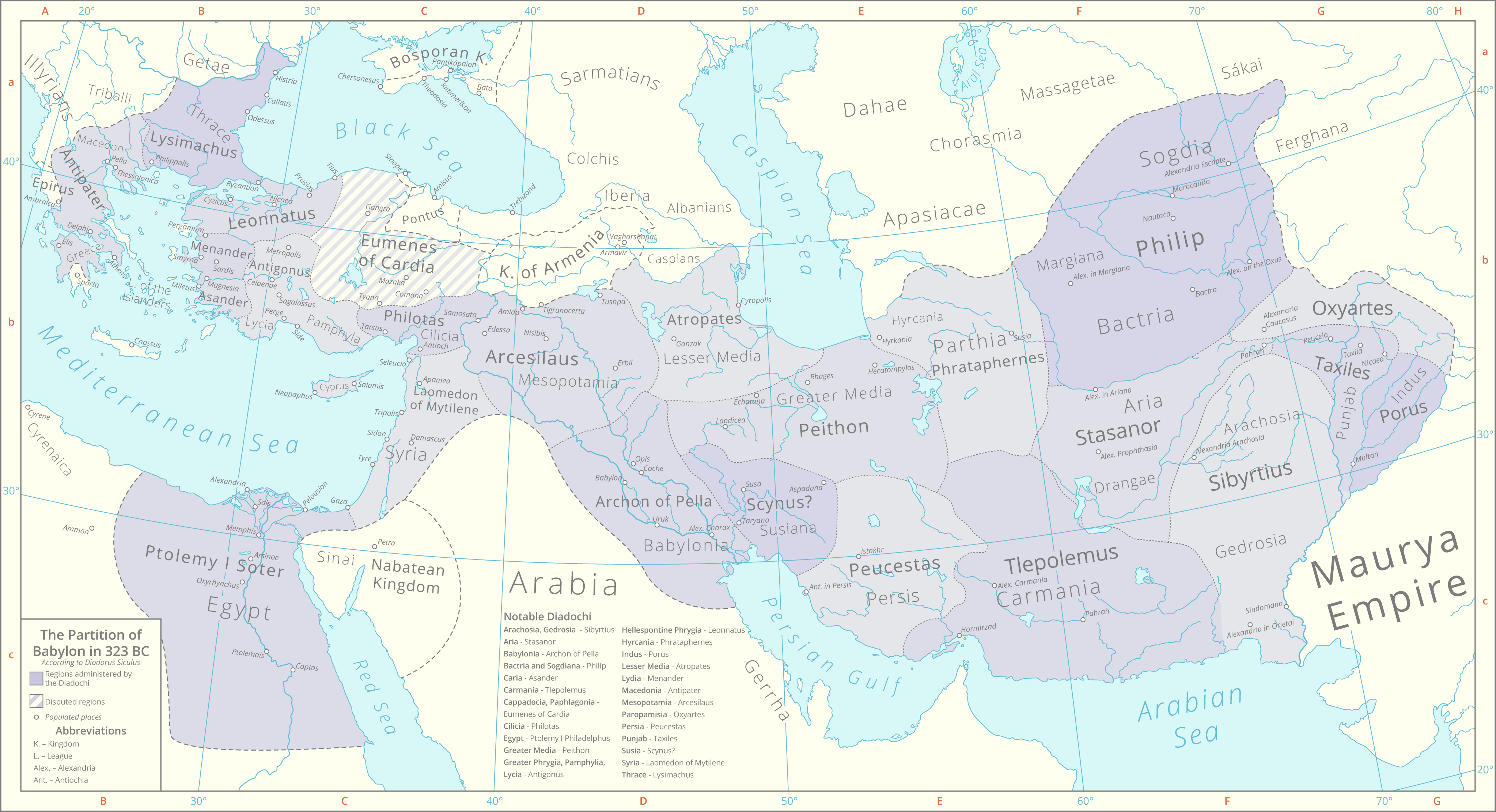|
Atropatene
Atropatene ( peo, Ātṛpātakāna; grc, Ἀτροπατηνή), also known as Media Atropatene, was an ancient Iranian kingdom established in by the Persian satrap Atropates. The kingdom, centered in present-day northern Iran, was ruled by Atropates' descendants until the early 1st-century AD, when the Parthian Arsacid dynasty supplanted them. It was conquered by the Sasanians in 226, and turned into a province governed by a ''marzban'' ("margrave"). Atropatene was the only Iranian region to remain under Zoroastrian authority from the Achaemenids to the Arab conquest without interruption, aside from being briefly ruled by the Macedonian king Alexander the Great (). The name of Atropatene was also the nominal ancestor of the name of the historic Azerbaijan region in Iran. Name According to Strabo, the name of Atropatene derived from the name of Atropates, the commander of the Achaemenid Empire. As he writes in his book “Geography”: "Media is divided into two parts. One ... [...More Info...] [...Related Items...] OR: [Wikipedia] [Google] [Baidu] |
Ganzak
Ganzak ( Persian: گنزک ''Ganzak'', Greek: ''Γάζακα'' ''Gazaka'', Latin: ''Gaza'', ''Gazaca'', ''Ganzaga'', Arabic: ''Janza'', ''Jaznaq'', Armenian: Գանձակ Gandzak), is an ancient town founded in northwestern Iran. The city stood somewhere south of Lake Urmia, and it has been postulated that the Persian nobleman Atropates chose the city as his capital. The exact location, according to Minorsky, Schippmann, and Boyce, is identified as being the ruins (37.011555°N, 46.193187°E) at Leylan, Malekan County in the Miandoab plain.M. BoyceGanzak in Encyclopaedia Iranica, vol. 10, 2001. Etymology The word means “treasury” and is of Median origin, and was adopted into Persian by the Achaemenid Empire. The name is related to the Persian word for treasury i.e. گنج ''Ganj''. History Ganzak was built by the Achaemenids, and was the seat of the satrap of Media. During the 4th-century BC, the city became part of the domains of the Persian aristocrat Atropates, w ... [...More Info...] [...Related Items...] OR: [Wikipedia] [Google] [Baidu] |
Atropates
Atropates ( peo, *Ātr̥pātaʰ and Middle Persian ; grc, Ἀτροπάτης ; c. 370 BC - after 321 BC) was a Persian nobleman who served Darius III, then Alexander the Great, and eventually founded an independent kingdom and dynasty that was named after him. Diodorus (18.4) refers to him as (), while Quintus Curtius (8.3.17) erroneously names him 'Arsaces'. Biography Towards the end of the Achaemenid Empire, Atropates was governor (''satrap'') of the Achaemenid province of Media. In the decisive Battle of Gaugamela (October 331 BCE) between Darius and Alexander, Atropates commanded the Achaemenid troops of Media and Sacasene. Following his defeat in that battle, Darius fled to the Median capital of Ecbatana, where Atropates gave him hospitality. Darius attempted to raise a new army but was forced to flee Ecbatana in June 330 BCE. After Darius' death a month later at the hands of Bessus, Atropates surrendered to Alexander. Alexander initially chose Oxydates as satra ... [...More Info...] [...Related Items...] OR: [Wikipedia] [Google] [Baidu] |
Azerbaijan (Iran)
Azerbaijan or Azarbaijan ( fa, آذربایجان, ''Āzarbāijān'' ; az-Arab, آذربایجان, ''Āzerbāyjān'' ), also known as Iranian Azerbaijan, is a historical region in northwestern Iran that borders Iraq, Turkey, the Nakhchivan Autonomous Republic, Armenia, and the Republic of Azerbaijan. Iranian Azerbaijan includes three northwestern Iranian provinces: West Azerbaijan, East Azerbaijan and Ardabil. Some authors also include Zanjan in this list, some in a geographical sense, others only culturally (due to the predominance of the Azeri Turkic population there). The region is mostly populated by Azerbaijanis, with minority populations of Kurds, Armenians, Tats, Talysh, Assyrians and Persians. Iranian Azerbaijan is the land originally and historically called Azerbaijan; the Azerbaijani-populated Republic of Azerbaijan appropriated the name of the neighbouring Azerbaijani-populated region in Iran during the 20th century. Historic Azerbaijan was called '' Atr ... [...More Info...] [...Related Items...] OR: [Wikipedia] [Google] [Baidu] |
Arsacid Dynasty
The Parthian Empire (), also known as the Arsacid Empire (), was a major Iranian political and cultural power in ancient Iran from 247 BC to 224 AD. Its latter name comes from its founder, Arsaces I, who led the Parni tribe in conquering the region of Parthia in Iran's northeast, then a satrapy (province) under Andragoras, who was rebelling against the Seleucid Empire. Mithridates I (r. c. 171–132 BC) greatly expanded the empire by seizing Media and Mesopotamia from the Seleucids. At its height, the Parthian Empire stretched from the northern reaches of the Euphrates, in what is now central-eastern Turkey, to present-day Afghanistan and western Pakistan. The empire, located on the Silk Road trade route between the Roman Empire in the Mediterranean Basin and the Han dynasty of China, became a center of trade and commerce. The Parthians largely adopted the art, architecture, religious beliefs, and royal insignia of their culturally heterogeneous empi ... [...More Info...] [...Related Items...] OR: [Wikipedia] [Google] [Baidu] |
Parthian Empire
The Parthian Empire (), also known as the Arsacid Empire (), was a major Iranian political and cultural power in ancient Iran from 247 BC to 224 AD. Its latter name comes from its founder, Arsaces I, who led the Parni tribe in conquering the region of Parthia in Iran's northeast, then a satrapy (province) under Andragoras, who was rebelling against the Seleucid Empire. Mithridates I (r. c. 171–132 BC) greatly expanded the empire by seizing Media and Mesopotamia from the Seleucids. At its height, the Parthian Empire stretched from the northern reaches of the Euphrates, in what is now central-eastern Turkey, to present-day Afghanistan and western Pakistan. The empire, located on the Silk Road trade route between the Roman Empire in the Mediterranean Basin and the Han dynasty of China, became a center of trade and commerce. The Parthians largely adopted the art, architecture, religious beliefs, and royal insignia of their culturally heterogene ... [...More Info...] [...Related Items...] OR: [Wikipedia] [Google] [Baidu] |
Peithon
Peithon or Pithon (Greek: ''Πείθων'' or ''Πίθων'', 355 – 314 BC) was the son of Crateuas, a nobleman from Eordaia in western Macedonia. He was famous for being one of the bodyguards of Alexander the Great, becoming the later satrap of Media, and claiming to be one of the diadochi. Peithon was named one of the seven (later eight) Somatophylakes "bodyguards" of Alexander in 335 BC. After Alexander's death in 323 BC, Peithon was made the satrap of Media, the strategically important region that controlled all roads between east and west. The satrapy was too large for one man; Peithon would be very powerful, and could destabilize the entire empire. Therefore, he had to give up the northern part, which was given to Atropates; from then on the region was known as Media Atropatene. The soldiers who remained in the eastern part of Alexander's realm after his death grew agitated by their lengthy stay abroad, and began spontaneous revolts. The regent Perdiccas sent ... [...More Info...] [...Related Items...] OR: [Wikipedia] [Google] [Baidu] |
Ecbatana
Ecbatana ( peo, 𐏃𐎥𐎶𐎫𐎠𐎴 ''Hagmatāna'' or ''Haŋmatāna'', literally "the place of gathering" according to Darius I's inscription at Bisotun; Persian: هگمتانه; Middle Persian: 𐭠𐭧𐭬𐭲𐭠𐭭; Parthian: 𐭀𐭇𐭌𐭕𐭍 ''Ahmadān''; Akkadian: ''kura-gam-ta-nu''; Elamite: 𒀝𒈠𒁕𒈾 ''Ag-ma-da-na''; arc, אַחְמְתָא ''Aḥmeta''; grc, Ἀγβάτανα or ) was an ancient city, which was first the capital of Media in western Iran, and later was an important city in Persian, Seleucid, and Parthian empires.Nardo, Don. "Ecbatana." ''The Greenhaven Encyclopedia of Ancient Mesopotamia'', edited by Robert B. Kebric, Greenhaven Press, 2007, pp. 97-98. ''Gale In Context: World History'', link.gale.com/apps/doc/CX3205100129/WHIC?u=wylrc_uwyoming&sid=summon&xid=e9682d3c. Accessed 20 Nov. 2022. It is believed that Ecbatana is located in the Zagros Mountains, the east of central Mesopotamia, on Hagmatana Hill (Tappe-ye Hagmatāna), ... [...More Info...] [...Related Items...] OR: [Wikipedia] [Google] [Baidu] |
Sasanians
The Sasanian () or Sassanid Empire, officially known as the Empire of Iranians (, ) and also referred to by historians as the Neo-Persian Empire, was the last Iranian empire before the early Muslim conquests of the 7th-8th centuries AD. Named after the House of Sasan, it endured for over four centuries, from 224 to 651 AD, making it the longest-lived Persian imperial dynasty. The Sasanian Empire succeeded the Parthian Empire, and re-established the Persians as a major power in late antiquity alongside its neighbouring arch-rival, the Roman Empire (after 395 the Byzantine Empire).Norman A. Stillman ''The Jews of Arab Lands'' pp 22 Jewish Publication Society, 1979 International Congress of Byzantine Studies ''Proceedings of the 21st International Congress of Byzantine Studies, London, 21–26 August 2006, Volumes 1–3'' pp 29. Ashgate Pub Co, 2006 The empire was founded by Ardashir I, an Iranian ruler who rose to power as Parthia weakened from internal strife and wars with th ... [...More Info...] [...Related Items...] OR: [Wikipedia] [Google] [Baidu] |
Antiochus III The Great
Antiochus III the Great (; grc-gre, Ἀντίoχoς Μέγας ; c. 2413 July 187 BC) was a Greek Hellenistic king and the 6th ruler of the Seleucid Empire, reigning from 222 to 187 BC. He ruled over the region of Syria and large parts of the rest of western Asia towards the end of the 3rd century BC. Rising to the throne at the age of eighteen in 222 BC, his early campaigns against the Ptolemaic Kingdom were unsuccessful, but in the following years Antiochus gained several military victories and substantially expanded the empire's territory. His traditional designation, ''the Great'', reflects an epithet he assumed. He also assumed the title ''Basileus Megas'' (Greek for "Great King"), the traditional title of the Persian kings. A militarily active ruler, Antiochus restored much of the territory of the Seleucid Empire, before suffering a serious setback, towards the end of his reign, in his war against Rome. Declaring himself the "champion of Greek freedom against Roman dominat ... [...More Info...] [...Related Items...] OR: [Wikipedia] [Google] [Baidu] |
Matiene
Matiene was the name of a kingdom in northwestern Iran on the lands of the earlier kingdom of the Mannae. Ancient historians including Strabo, Ptolemy, Herodotus, Polybius, and Pliny mention names such as Mantiane, Martiane, Matiana, Matiani, Matiene, Martuni to designate a region located to the northwest of Media." Etymology The name Matiene may be related to Mitanni, the name of a state some 800 years earlier, which was founded by an Indo-Aryan ruling class governing the Hurrian population. The name Matiene was applied also to the neighboring Lake Matianus (Lake Urmia) located immediately to the east of the Matieni people. The Iranian root "Mati-" meaning "to tower, to stand out" (from the same Indo-European root that gives us the word "mountain") might explain the name. History The Mannaeans who probably spoke a Hurro-Urartian language, were subdued by the Scytho- Kimmerians during the seventh and eighth centuries BC and assimilated by Matienes. Matiene was ultimately ... [...More Info...] [...Related Items...] OR: [Wikipedia] [Google] [Baidu] |
Partition Of Babylon
The Partition of Babylon was the first of the conferences and ensuing agreements that divided the territories of Alexander the Great. It was held at Babylon in June 323 BC. Alexander’s death at the age of 32 had left an empire that stretched from Greece all the way to India. The issue of succession resulted from the claims of the various supporters of Philip Arrhidaeus (Alexander’s half-brother), and the as-of-then unborn child of Alexander and Roxana, among others. The settlement saw Arrhidaeus and Alexander’s child designated as joint kings with Perdiccas serving as regent. The territories of the empire became satrapies divided between the senior officers of the Macedonian army and some local governors and rulers. The partition was solidified at the further agreements at Triparadisus and Persepolis over the following years and began the series of conflicts that comprise the Wars of the Diadochi. The term "Partition of Babylon" is a modern designation. Definition of pa ... [...More Info...] [...Related Items...] OR: [Wikipedia] [Google] [Baidu] |
Diadochi
The Diadochi (; singular: Diadochus; from grc-gre, Διάδοχοι, Diádochoi, Successors, ) were the rival generals, families, and friends of Alexander the Great who fought for control over his empire after his death in 323 BC. The Wars of the Diadochi mark the beginning of the Hellenistic period from the Mediterranean Sea to the Indus River Valley. The most notable Diadochi include Ptolemy I Soter, Ptolemy, Antigonus I Monophthalmus, Antigonus, Cassander, and Seleucus I Nicator, Seleucus as the last remaining at the end of the Wars of the Diadochi, Wars of the Successors, ruling in Egypt, Anatolia, Asia-Minor, Macedonia (ancient kingdom), Macedon and Iran, Persia respectively, all forging dynasties lasting several centuries. Background Ancient role In ancient Greek, is a noun (substantive or adjective) formed from the verb, ''diadechesthai'', "succeed to," a compound of ''dia-'' and ''dechesthai'', "receive." The word-set descends straightforwardly from Proto-Ind ... [...More Info...] [...Related Items...] OR: [Wikipedia] [Google] [Baidu] |



_Azerbaijan.png)
%2C_Nisa_mint.jpg)


.jpg)
